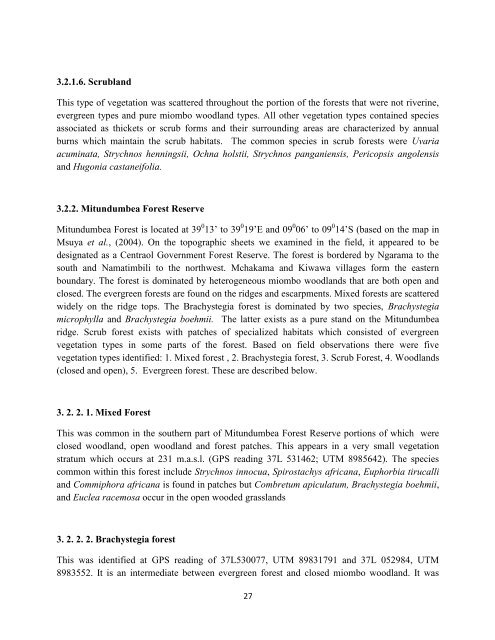Biodiversity Surveys of Poorly Known Coastal Forests of ...
Biodiversity Surveys of Poorly Known Coastal Forests of ...
Biodiversity Surveys of Poorly Known Coastal Forests of ...
Create successful ePaper yourself
Turn your PDF publications into a flip-book with our unique Google optimized e-Paper software.
3.2.1.6. Scrubland<br />
This type <strong>of</strong> vegetation was scattered throughout the portion <strong>of</strong> the forests that were not riverine,<br />
evergreen types and pure miombo woodland types. All other vegetation types contained species<br />
associated as thickets or scrub forms and their surrounding areas are characterized by annual<br />
burns which maintain the scrub habitats. The common species in scrub forests were Uvaria<br />
acuminata, Strychnos henningsii, Ochna holstii, Strychnos panganiensis, Pericopsis angolensis<br />
and Hugonia castaneifolia.<br />
3.2.2. Mitundumbea Forest Reserve<br />
Mitundumbea Forest is located at 39 0 13’ to 39 0 19’E and 09 0 06’ to 09 0 14’S (based on the map in<br />
Msuya et al., (2004). On the topographic sheets we examined in the field, it appeared to be<br />
designated as a Centraol Government Forest Reserve. The forest is bordered by Ngarama to the<br />
south and Namatimbili to the northwest. Mchakama and Kiwawa villages form the eastern<br />
boundary. The forest is dominated by heterogeneous miombo woodlands that are both open and<br />
closed. The evergreen forests are found on the ridges and escarpments. Mixed forests are scattered<br />
widely on the ridge tops. The Brachystegia forest is dominated by two species, Brachystegia<br />
microphylla and Brachystegia boehmii. The latter exists as a pure stand on the Mitundumbea<br />
ridge. Scrub forest exists with patches <strong>of</strong> specialized habitats which consisted <strong>of</strong> evergreen<br />
vegetation types in some parts <strong>of</strong> the forest. Based on field observations there were five<br />
vegetation types identified: 1. Mixed forest , 2. Brachystegia forest, 3. Scrub Forest, 4. Woodlands<br />
(closed and open), 5. Evergreen forest. These are described below.<br />
3. 2. 2. 1. Mixed Forest<br />
This was common in the southern part <strong>of</strong> Mitundumbea Forest Reserve portions <strong>of</strong> which were<br />
closed woodland, open woodland and forest patches. This appears in a very small vegetation<br />
stratum which occurs at 231 m.a.s.l. (GPS reading 37L 531462; UTM 8985642). The species<br />
common within this forest include Strychnos innocua, Spirostachys africana, Euphorbia tirucalli<br />
and Commiphora africana is found in patches but Combretum apiculatum, Brachystegia boehmii,<br />
and Euclea racemosa occur in the open wooded grasslands<br />
3. 2. 2. 2. Brachystegia forest<br />
This was identified at GPS reading <strong>of</strong> 37L530077, UTM 89831791 and 37L 052984, UTM<br />
8983552. It is an intermediate between evergreen forest and closed miombo woodland. It was<br />
27

















